BM414 - Financial Decision Making: Accounting, Finance Roles & Ratios
VerifiedAdded on 2023/06/18
|13
|3903
|275
Report
AI Summary
This report provides a comprehensive analysis of financial decision-making within SKANSKA PLC, a British subsidiary of a Swedish global contractor. It critically evaluates the functions, roles, and duties of both the accounting and finance departments, including financial accounting, management accounting, tax functions, auditing, investment, financing, dividend policy, and working capital management. The report also includes a ratio analysis of SKANSKA's financial performance for the years 2018 and 2019, examining key metrics such as Return on Capital Employed (ROCE), Net Profit Margin, Current Ratio, Debtor's Collection Period, and Creditor's Collection Period, with detailed interpretations of these ratios to assess the company's financial health and compare its performance over the two years.

Financial Decision Making
(Business Management)
(Business Management)
Paraphrase This Document
Need a fresh take? Get an instant paraphrase of this document with our AI Paraphraser
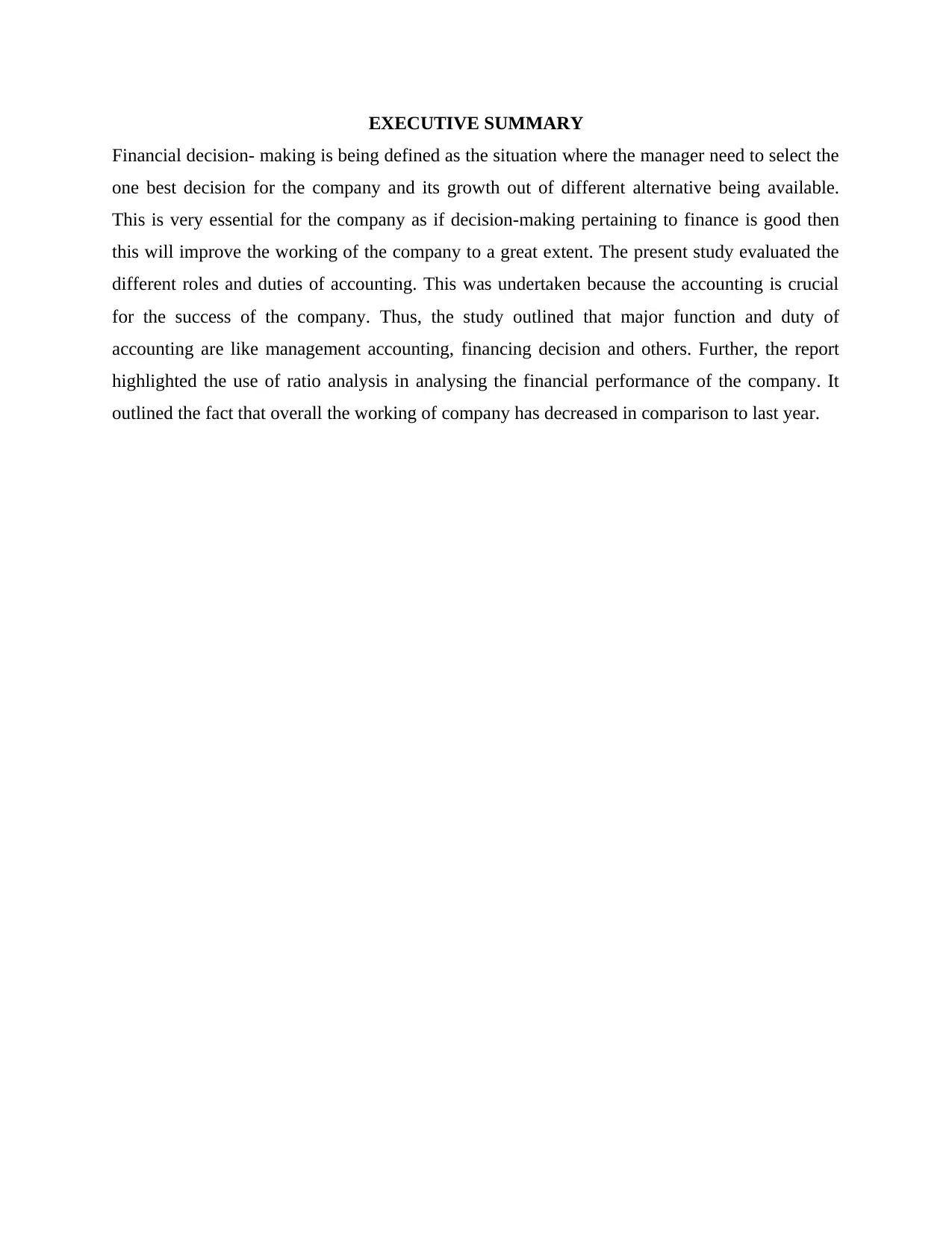
EXECUTIVE SUMMARY
Financial decision- making is being defined as the situation where the manager need to select the
one best decision for the company and its growth out of different alternative being available.
This is very essential for the company as if decision-making pertaining to finance is good then
this will improve the working of the company to a great extent. The present study evaluated the
different roles and duties of accounting. This was undertaken because the accounting is crucial
for the success of the company. Thus, the study outlined that major function and duty of
accounting are like management accounting, financing decision and others. Further, the report
highlighted the use of ratio analysis in analysing the financial performance of the company. It
outlined the fact that overall the working of company has decreased in comparison to last year.
Financial decision- making is being defined as the situation where the manager need to select the
one best decision for the company and its growth out of different alternative being available.
This is very essential for the company as if decision-making pertaining to finance is good then
this will improve the working of the company to a great extent. The present study evaluated the
different roles and duties of accounting. This was undertaken because the accounting is crucial
for the success of the company. Thus, the study outlined that major function and duty of
accounting are like management accounting, financing decision and others. Further, the report
highlighted the use of ratio analysis in analysing the financial performance of the company. It
outlined the fact that overall the working of company has decreased in comparison to last year.
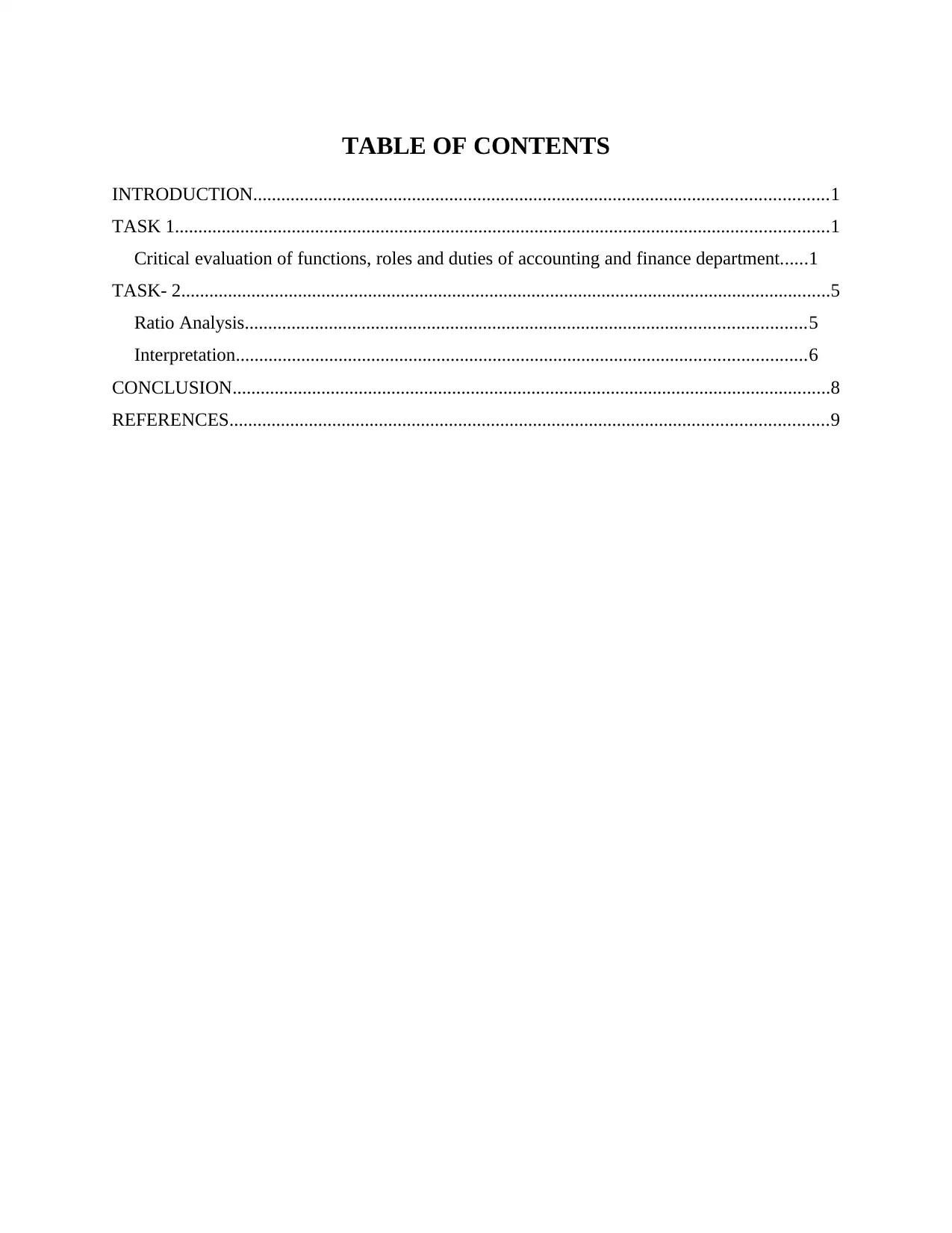
TABLE OF CONTENTS
INTRODUCTION...........................................................................................................................1
TASK 1............................................................................................................................................1
Critical evaluation of functions, roles and duties of accounting and finance department......1
TASK- 2...........................................................................................................................................5
Ratio Analysis........................................................................................................................5
Interpretation..........................................................................................................................6
CONCLUSION................................................................................................................................8
REFERENCES................................................................................................................................9
INTRODUCTION...........................................................................................................................1
TASK 1............................................................................................................................................1
Critical evaluation of functions, roles and duties of accounting and finance department......1
TASK- 2...........................................................................................................................................5
Ratio Analysis........................................................................................................................5
Interpretation..........................................................................................................................6
CONCLUSION................................................................................................................................8
REFERENCES................................................................................................................................9
⊘ This is a preview!⊘
Do you want full access?
Subscribe today to unlock all pages.

Trusted by 1+ million students worldwide
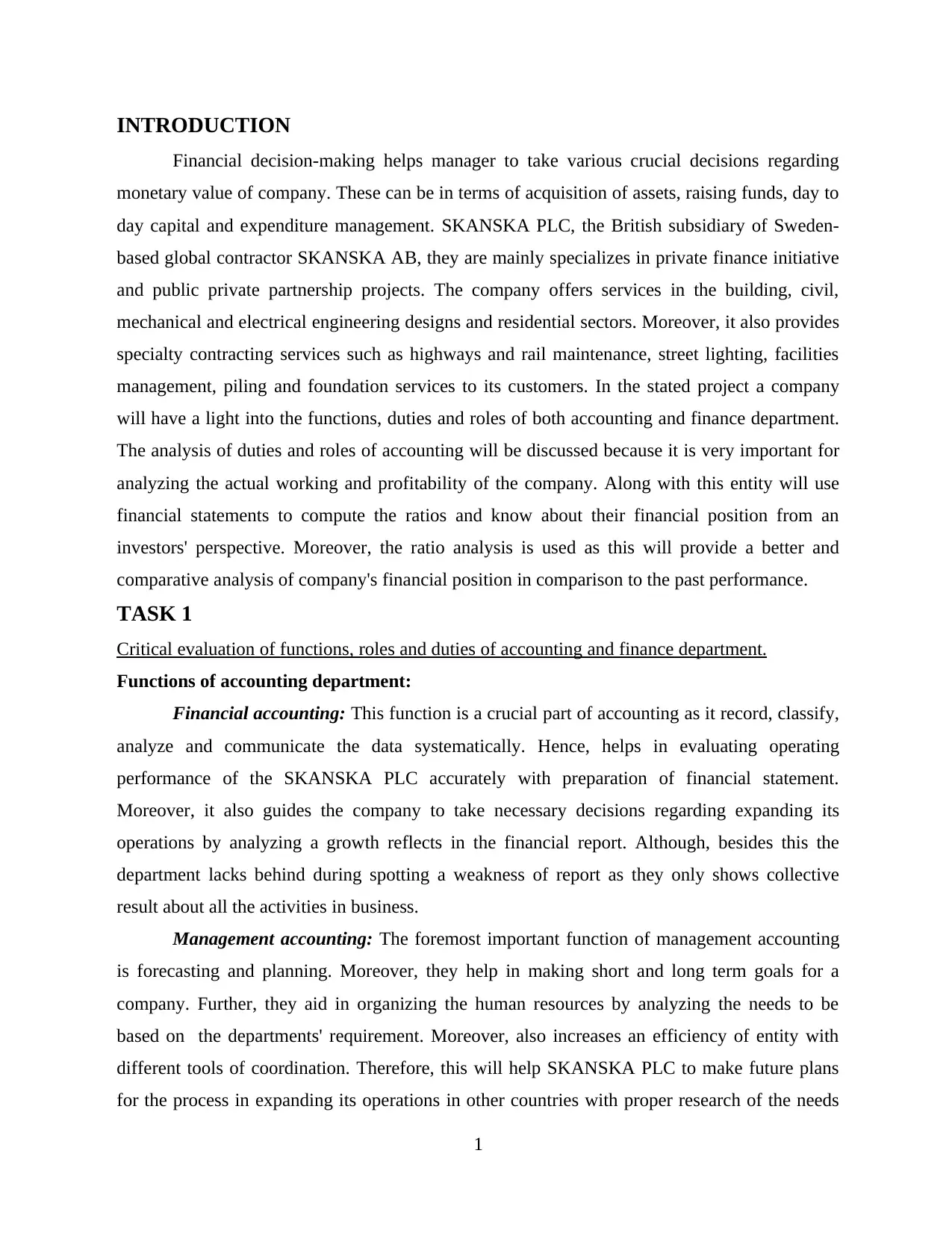
INTRODUCTION
Financial decision-making helps manager to take various crucial decisions regarding
monetary value of company. These can be in terms of acquisition of assets, raising funds, day to
day capital and expenditure management. SKANSKA PLC, the British subsidiary of Sweden-
based global contractor SKANSKA AB, they are mainly specializes in private finance initiative
and public private partnership projects. The company offers services in the building, civil,
mechanical and electrical engineering designs and residential sectors. Moreover, it also provides
specialty contracting services such as highways and rail maintenance, street lighting, facilities
management, piling and foundation services to its customers. In the stated project a company
will have a light into the functions, duties and roles of both accounting and finance department.
The analysis of duties and roles of accounting will be discussed because it is very important for
analyzing the actual working and profitability of the company. Along with this entity will use
financial statements to compute the ratios and know about their financial position from an
investors' perspective. Moreover, the ratio analysis is used as this will provide a better and
comparative analysis of company's financial position in comparison to the past performance.
TASK 1
Critical evaluation of functions, roles and duties of accounting and finance department.
Functions of accounting department:
Financial accounting: This function is a crucial part of accounting as it record, classify,
analyze and communicate the data systematically. Hence, helps in evaluating operating
performance of the SKANSKA PLC accurately with preparation of financial statement.
Moreover, it also guides the company to take necessary decisions regarding expanding its
operations by analyzing a growth reflects in the financial report. Although, besides this the
department lacks behind during spotting a weakness of report as they only shows collective
result about all the activities in business.
Management accounting: The foremost important function of management accounting
is forecasting and planning. Moreover, they help in making short and long term goals for a
company. Further, they aid in organizing the human resources by analyzing the needs to be
based on the departments' requirement. Moreover, also increases an efficiency of entity with
different tools of coordination. Therefore, this will help SKANSKA PLC to make future plans
for the process in expanding its operations in other countries with proper research of the needs
1
Financial decision-making helps manager to take various crucial decisions regarding
monetary value of company. These can be in terms of acquisition of assets, raising funds, day to
day capital and expenditure management. SKANSKA PLC, the British subsidiary of Sweden-
based global contractor SKANSKA AB, they are mainly specializes in private finance initiative
and public private partnership projects. The company offers services in the building, civil,
mechanical and electrical engineering designs and residential sectors. Moreover, it also provides
specialty contracting services such as highways and rail maintenance, street lighting, facilities
management, piling and foundation services to its customers. In the stated project a company
will have a light into the functions, duties and roles of both accounting and finance department.
The analysis of duties and roles of accounting will be discussed because it is very important for
analyzing the actual working and profitability of the company. Along with this entity will use
financial statements to compute the ratios and know about their financial position from an
investors' perspective. Moreover, the ratio analysis is used as this will provide a better and
comparative analysis of company's financial position in comparison to the past performance.
TASK 1
Critical evaluation of functions, roles and duties of accounting and finance department.
Functions of accounting department:
Financial accounting: This function is a crucial part of accounting as it record, classify,
analyze and communicate the data systematically. Hence, helps in evaluating operating
performance of the SKANSKA PLC accurately with preparation of financial statement.
Moreover, it also guides the company to take necessary decisions regarding expanding its
operations by analyzing a growth reflects in the financial report. Although, besides this the
department lacks behind during spotting a weakness of report as they only shows collective
result about all the activities in business.
Management accounting: The foremost important function of management accounting
is forecasting and planning. Moreover, they help in making short and long term goals for a
company. Further, they aid in organizing the human resources by analyzing the needs to be
based on the departments' requirement. Moreover, also increases an efficiency of entity with
different tools of coordination. Therefore, this will help SKANSKA PLC to make future plans
for the process in expanding its operations in other countries with proper research of the needs
1
Paraphrase This Document
Need a fresh take? Get an instant paraphrase of this document with our AI Paraphraser
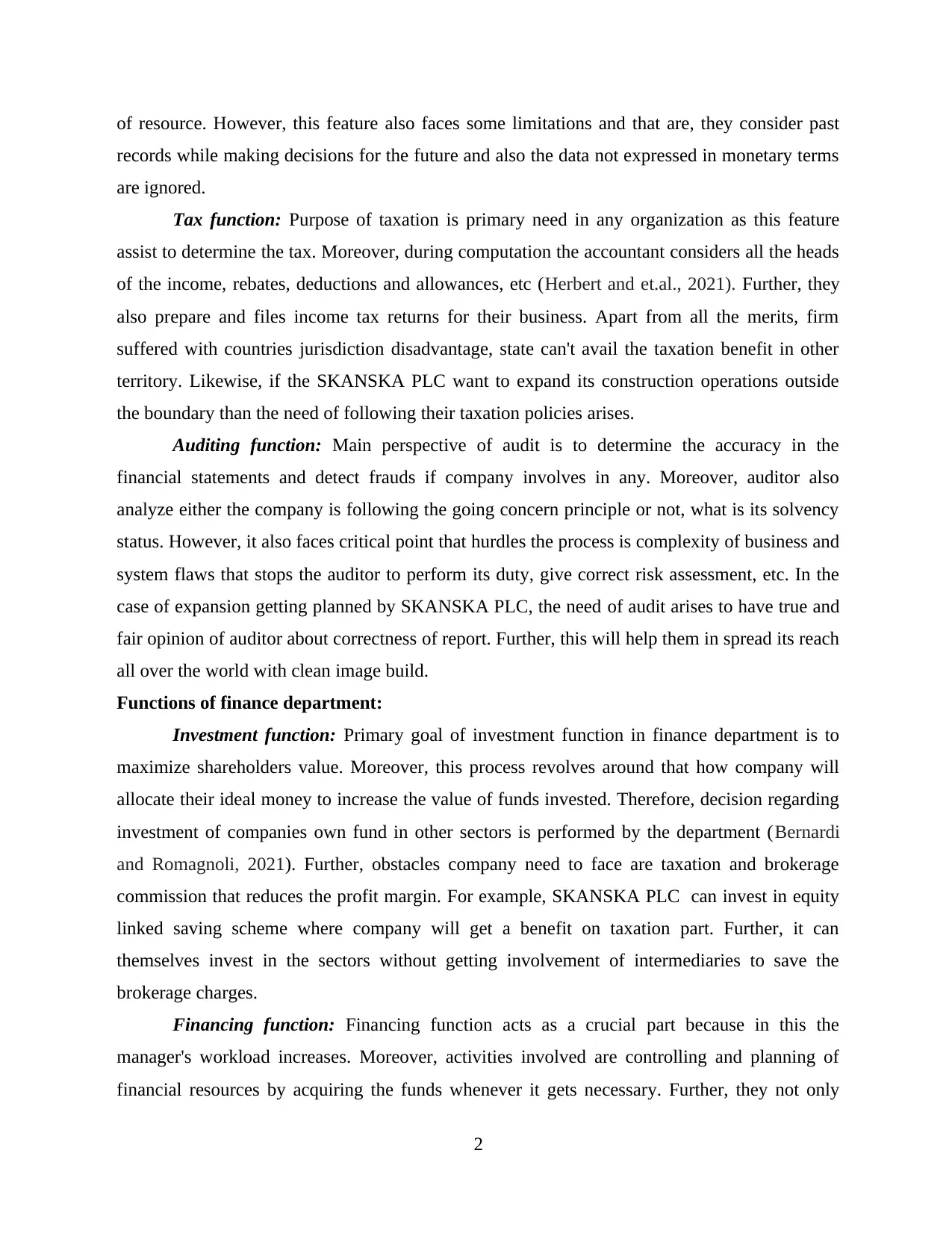
of resource. However, this feature also faces some limitations and that are, they consider past
records while making decisions for the future and also the data not expressed in monetary terms
are ignored.
Tax function: Purpose of taxation is primary need in any organization as this feature
assist to determine the tax. Moreover, during computation the accountant considers all the heads
of the income, rebates, deductions and allowances, etc (Herbert and et.al., 2021). Further, they
also prepare and files income tax returns for their business. Apart from all the merits, firm
suffered with countries jurisdiction disadvantage, state can't avail the taxation benefit in other
territory. Likewise, if the SKANSKA PLC want to expand its construction operations outside
the boundary than the need of following their taxation policies arises.
Auditing function: Main perspective of audit is to determine the accuracy in the
financial statements and detect frauds if company involves in any. Moreover, auditor also
analyze either the company is following the going concern principle or not, what is its solvency
status. However, it also faces critical point that hurdles the process is complexity of business and
system flaws that stops the auditor to perform its duty, give correct risk assessment, etc. In the
case of expansion getting planned by SKANSKA PLC, the need of audit arises to have true and
fair opinion of auditor about correctness of report. Further, this will help them in spread its reach
all over the world with clean image build.
Functions of finance department:
Investment function: Primary goal of investment function in finance department is to
maximize shareholders value. Moreover, this process revolves around that how company will
allocate their ideal money to increase the value of funds invested. Therefore, decision regarding
investment of companies own fund in other sectors is performed by the department (Bernardi
and Romagnoli, 2021). Further, obstacles company need to face are taxation and brokerage
commission that reduces the profit margin. For example, SKANSKA PLC can invest in equity
linked saving scheme where company will get a benefit on taxation part. Further, it can
themselves invest in the sectors without getting involvement of intermediaries to save the
brokerage charges.
Financing function: Financing function acts as a crucial part because in this the
manager's workload increases. Moreover, activities involved are controlling and planning of
financial resources by acquiring the funds whenever it gets necessary. Further, they not only
2
records while making decisions for the future and also the data not expressed in monetary terms
are ignored.
Tax function: Purpose of taxation is primary need in any organization as this feature
assist to determine the tax. Moreover, during computation the accountant considers all the heads
of the income, rebates, deductions and allowances, etc (Herbert and et.al., 2021). Further, they
also prepare and files income tax returns for their business. Apart from all the merits, firm
suffered with countries jurisdiction disadvantage, state can't avail the taxation benefit in other
territory. Likewise, if the SKANSKA PLC want to expand its construction operations outside
the boundary than the need of following their taxation policies arises.
Auditing function: Main perspective of audit is to determine the accuracy in the
financial statements and detect frauds if company involves in any. Moreover, auditor also
analyze either the company is following the going concern principle or not, what is its solvency
status. However, it also faces critical point that hurdles the process is complexity of business and
system flaws that stops the auditor to perform its duty, give correct risk assessment, etc. In the
case of expansion getting planned by SKANSKA PLC, the need of audit arises to have true and
fair opinion of auditor about correctness of report. Further, this will help them in spread its reach
all over the world with clean image build.
Functions of finance department:
Investment function: Primary goal of investment function in finance department is to
maximize shareholders value. Moreover, this process revolves around that how company will
allocate their ideal money to increase the value of funds invested. Therefore, decision regarding
investment of companies own fund in other sectors is performed by the department (Bernardi
and Romagnoli, 2021). Further, obstacles company need to face are taxation and brokerage
commission that reduces the profit margin. For example, SKANSKA PLC can invest in equity
linked saving scheme where company will get a benefit on taxation part. Further, it can
themselves invest in the sectors without getting involvement of intermediaries to save the
brokerage charges.
Financing function: Financing function acts as a crucial part because in this the
manager's workload increases. Moreover, activities involved are controlling and planning of
financial resources by acquiring the funds whenever it gets necessary. Further, they not only
2
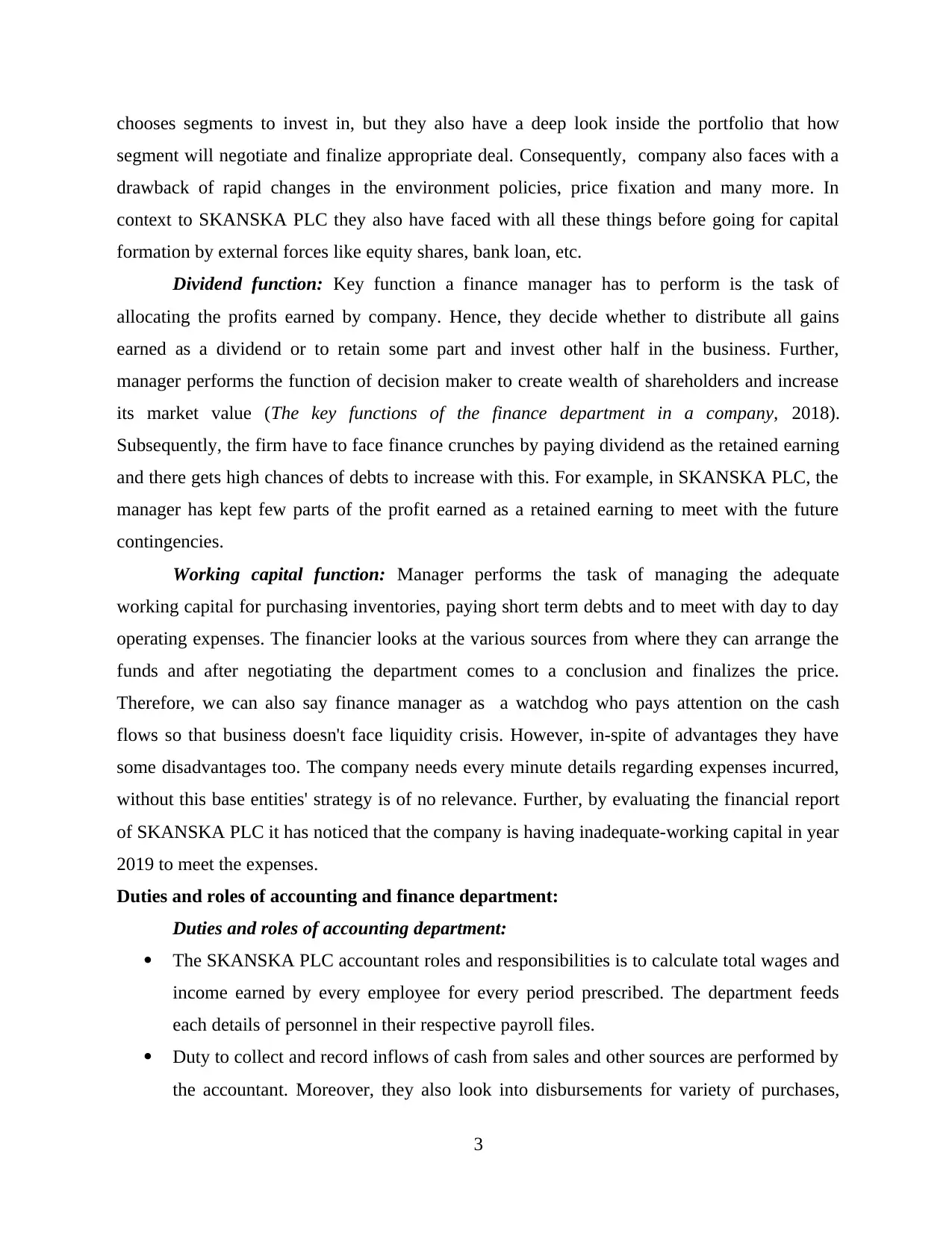
chooses segments to invest in, but they also have a deep look inside the portfolio that how
segment will negotiate and finalize appropriate deal. Consequently, company also faces with a
drawback of rapid changes in the environment policies, price fixation and many more. In
context to SKANSKA PLC they also have faced with all these things before going for capital
formation by external forces like equity shares, bank loan, etc.
Dividend function: Key function a finance manager has to perform is the task of
allocating the profits earned by company. Hence, they decide whether to distribute all gains
earned as a dividend or to retain some part and invest other half in the business. Further,
manager performs the function of decision maker to create wealth of shareholders and increase
its market value (The key functions of the finance department in a company, 2018).
Subsequently, the firm have to face finance crunches by paying dividend as the retained earning
and there gets high chances of debts to increase with this. For example, in SKANSKA PLC, the
manager has kept few parts of the profit earned as a retained earning to meet with the future
contingencies.
Working capital function: Manager performs the task of managing the adequate
working capital for purchasing inventories, paying short term debts and to meet with day to day
operating expenses. The financier looks at the various sources from where they can arrange the
funds and after negotiating the department comes to a conclusion and finalizes the price.
Therefore, we can also say finance manager as a watchdog who pays attention on the cash
flows so that business doesn't face liquidity crisis. However, in-spite of advantages they have
some disadvantages too. The company needs every minute details regarding expenses incurred,
without this base entities' strategy is of no relevance. Further, by evaluating the financial report
of SKANSKA PLC it has noticed that the company is having inadequate-working capital in year
2019 to meet the expenses.
Duties and roles of accounting and finance department:
Duties and roles of accounting department:
The SKANSKA PLC accountant roles and responsibilities is to calculate total wages and
income earned by every employee for every period prescribed. The department feeds
each details of personnel in their respective payroll files.
Duty to collect and record inflows of cash from sales and other sources are performed by
the accountant. Moreover, they also look into disbursements for variety of purchases,
3
segment will negotiate and finalize appropriate deal. Consequently, company also faces with a
drawback of rapid changes in the environment policies, price fixation and many more. In
context to SKANSKA PLC they also have faced with all these things before going for capital
formation by external forces like equity shares, bank loan, etc.
Dividend function: Key function a finance manager has to perform is the task of
allocating the profits earned by company. Hence, they decide whether to distribute all gains
earned as a dividend or to retain some part and invest other half in the business. Further,
manager performs the function of decision maker to create wealth of shareholders and increase
its market value (The key functions of the finance department in a company, 2018).
Subsequently, the firm have to face finance crunches by paying dividend as the retained earning
and there gets high chances of debts to increase with this. For example, in SKANSKA PLC, the
manager has kept few parts of the profit earned as a retained earning to meet with the future
contingencies.
Working capital function: Manager performs the task of managing the adequate
working capital for purchasing inventories, paying short term debts and to meet with day to day
operating expenses. The financier looks at the various sources from where they can arrange the
funds and after negotiating the department comes to a conclusion and finalizes the price.
Therefore, we can also say finance manager as a watchdog who pays attention on the cash
flows so that business doesn't face liquidity crisis. However, in-spite of advantages they have
some disadvantages too. The company needs every minute details regarding expenses incurred,
without this base entities' strategy is of no relevance. Further, by evaluating the financial report
of SKANSKA PLC it has noticed that the company is having inadequate-working capital in year
2019 to meet the expenses.
Duties and roles of accounting and finance department:
Duties and roles of accounting department:
The SKANSKA PLC accountant roles and responsibilities is to calculate total wages and
income earned by every employee for every period prescribed. The department feeds
each details of personnel in their respective payroll files.
Duty to collect and record inflows of cash from sales and other sources are performed by
the accountant. Moreover, they also look into disbursements for variety of purchases,
3
⊘ This is a preview!⊘
Do you want full access?
Subscribe today to unlock all pages.

Trusted by 1+ million students worldwide
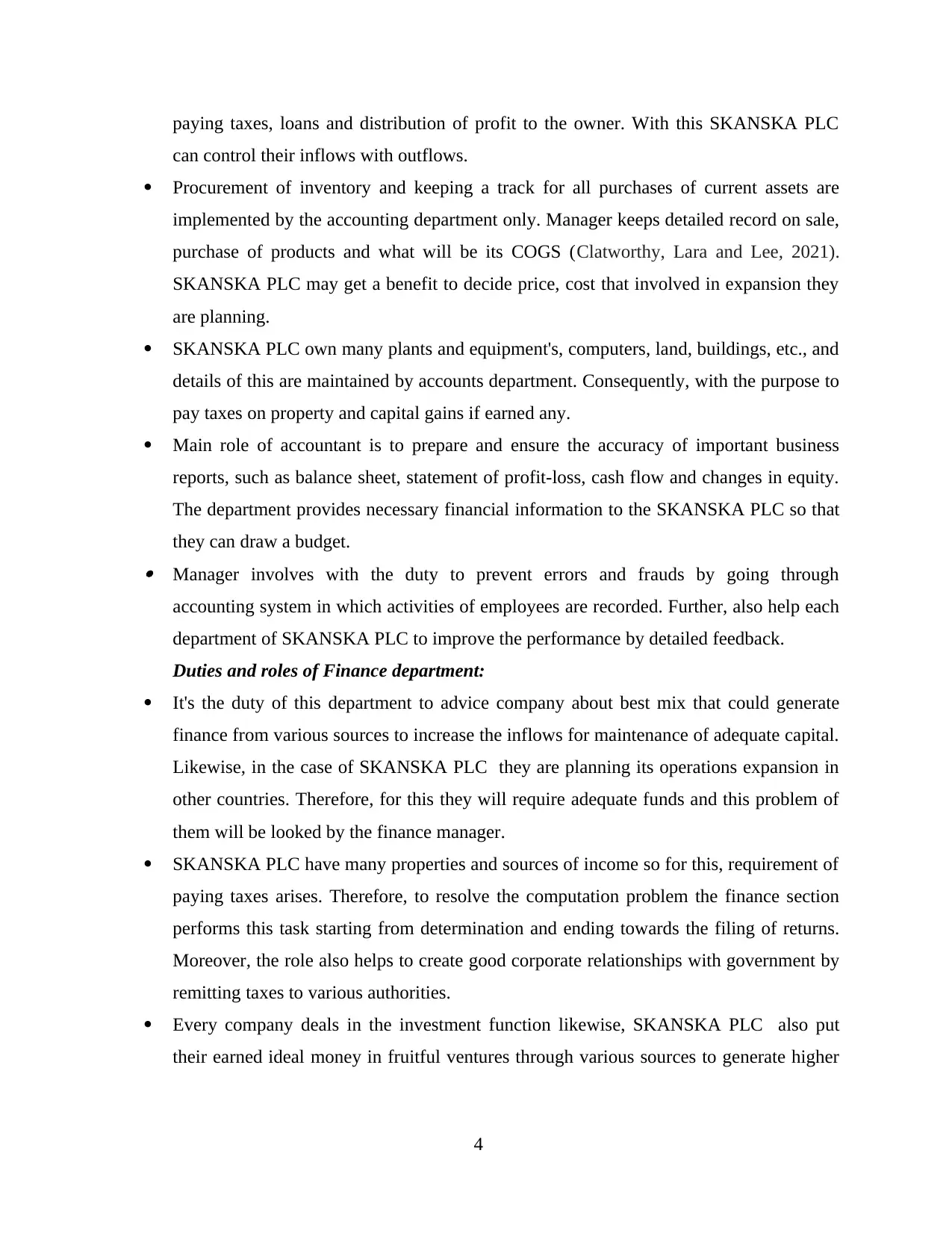
paying taxes, loans and distribution of profit to the owner. With this SKANSKA PLC
can control their inflows with outflows.
Procurement of inventory and keeping a track for all purchases of current assets are
implemented by the accounting department only. Manager keeps detailed record on sale,
purchase of products and what will be its COGS (Clatworthy, Lara and Lee, 2021).
SKANSKA PLC may get a benefit to decide price, cost that involved in expansion they
are planning.
SKANSKA PLC own many plants and equipment's, computers, land, buildings, etc., and
details of this are maintained by accounts department. Consequently, with the purpose to
pay taxes on property and capital gains if earned any.
Main role of accountant is to prepare and ensure the accuracy of important business
reports, such as balance sheet, statement of profit-loss, cash flow and changes in equity.
The department provides necessary financial information to the SKANSKA PLC so that
they can draw a budget. Manager involves with the duty to prevent errors and frauds by going through
accounting system in which activities of employees are recorded. Further, also help each
department of SKANSKA PLC to improve the performance by detailed feedback.
Duties and roles of Finance department:
It's the duty of this department to advice company about best mix that could generate
finance from various sources to increase the inflows for maintenance of adequate capital.
Likewise, in the case of SKANSKA PLC they are planning its operations expansion in
other countries. Therefore, for this they will require adequate funds and this problem of
them will be looked by the finance manager.
SKANSKA PLC have many properties and sources of income so for this, requirement of
paying taxes arises. Therefore, to resolve the computation problem the finance section
performs this task starting from determination and ending towards the filing of returns.
Moreover, the role also helps to create good corporate relationships with government by
remitting taxes to various authorities.
Every company deals in the investment function likewise, SKANSKA PLC also put
their earned ideal money in fruitful ventures through various sources to generate higher
4
can control their inflows with outflows.
Procurement of inventory and keeping a track for all purchases of current assets are
implemented by the accounting department only. Manager keeps detailed record on sale,
purchase of products and what will be its COGS (Clatworthy, Lara and Lee, 2021).
SKANSKA PLC may get a benefit to decide price, cost that involved in expansion they
are planning.
SKANSKA PLC own many plants and equipment's, computers, land, buildings, etc., and
details of this are maintained by accounts department. Consequently, with the purpose to
pay taxes on property and capital gains if earned any.
Main role of accountant is to prepare and ensure the accuracy of important business
reports, such as balance sheet, statement of profit-loss, cash flow and changes in equity.
The department provides necessary financial information to the SKANSKA PLC so that
they can draw a budget. Manager involves with the duty to prevent errors and frauds by going through
accounting system in which activities of employees are recorded. Further, also help each
department of SKANSKA PLC to improve the performance by detailed feedback.
Duties and roles of Finance department:
It's the duty of this department to advice company about best mix that could generate
finance from various sources to increase the inflows for maintenance of adequate capital.
Likewise, in the case of SKANSKA PLC they are planning its operations expansion in
other countries. Therefore, for this they will require adequate funds and this problem of
them will be looked by the finance manager.
SKANSKA PLC have many properties and sources of income so for this, requirement of
paying taxes arises. Therefore, to resolve the computation problem the finance section
performs this task starting from determination and ending towards the filing of returns.
Moreover, the role also helps to create good corporate relationships with government by
remitting taxes to various authorities.
Every company deals in the investment function likewise, SKANSKA PLC also put
their earned ideal money in fruitful ventures through various sources to generate higher
4
Paraphrase This Document
Need a fresh take? Get an instant paraphrase of this document with our AI Paraphraser
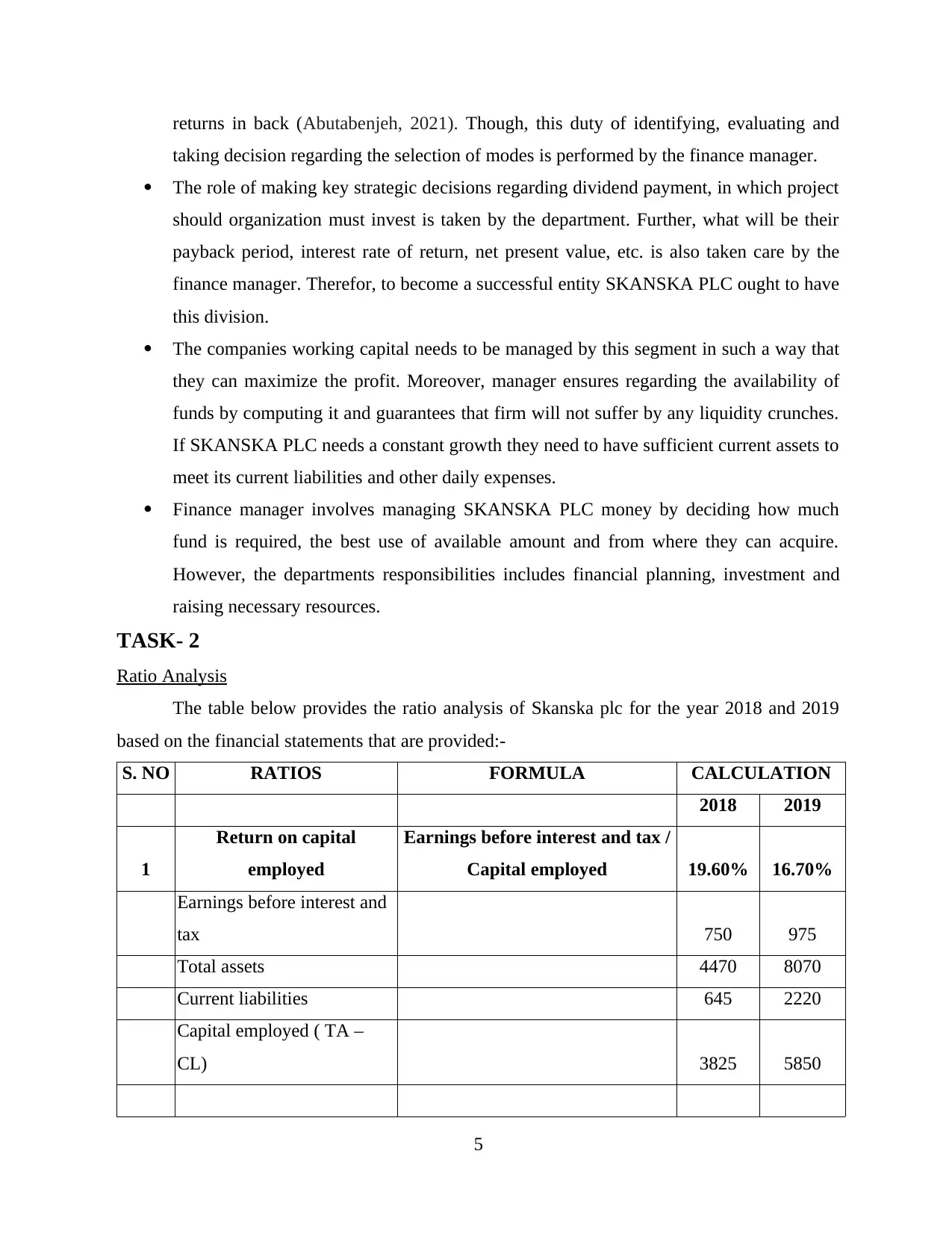
returns in back (Abutabenjeh, 2021). Though, this duty of identifying, evaluating and
taking decision regarding the selection of modes is performed by the finance manager.
The role of making key strategic decisions regarding dividend payment, in which project
should organization must invest is taken by the department. Further, what will be their
payback period, interest rate of return, net present value, etc. is also taken care by the
finance manager. Therefor, to become a successful entity SKANSKA PLC ought to have
this division.
The companies working capital needs to be managed by this segment in such a way that
they can maximize the profit. Moreover, manager ensures regarding the availability of
funds by computing it and guarantees that firm will not suffer by any liquidity crunches.
If SKANSKA PLC needs a constant growth they need to have sufficient current assets to
meet its current liabilities and other daily expenses.
Finance manager involves managing SKANSKA PLC money by deciding how much
fund is required, the best use of available amount and from where they can acquire.
However, the departments responsibilities includes financial planning, investment and
raising necessary resources.
TASK- 2
Ratio Analysis
The table below provides the ratio analysis of Skanska plc for the year 2018 and 2019
based on the financial statements that are provided:-
S. NO RATIOS FORMULA CALCULATION
2018 2019
1
Return on capital
employed
Earnings before interest and tax /
Capital employed 19.60% 16.70%
Earnings before interest and
tax 750 975
Total assets 4470 8070
Current liabilities 645 2220
Capital employed ( TA –
CL) 3825 5850
5
taking decision regarding the selection of modes is performed by the finance manager.
The role of making key strategic decisions regarding dividend payment, in which project
should organization must invest is taken by the department. Further, what will be their
payback period, interest rate of return, net present value, etc. is also taken care by the
finance manager. Therefor, to become a successful entity SKANSKA PLC ought to have
this division.
The companies working capital needs to be managed by this segment in such a way that
they can maximize the profit. Moreover, manager ensures regarding the availability of
funds by computing it and guarantees that firm will not suffer by any liquidity crunches.
If SKANSKA PLC needs a constant growth they need to have sufficient current assets to
meet its current liabilities and other daily expenses.
Finance manager involves managing SKANSKA PLC money by deciding how much
fund is required, the best use of available amount and from where they can acquire.
However, the departments responsibilities includes financial planning, investment and
raising necessary resources.
TASK- 2
Ratio Analysis
The table below provides the ratio analysis of Skanska plc for the year 2018 and 2019
based on the financial statements that are provided:-
S. NO RATIOS FORMULA CALCULATION
2018 2019
1
Return on capital
employed
Earnings before interest and tax /
Capital employed 19.60% 16.70%
Earnings before interest and
tax 750 975
Total assets 4470 8070
Current liabilities 645 2220
Capital employed ( TA –
CL) 3825 5850
5
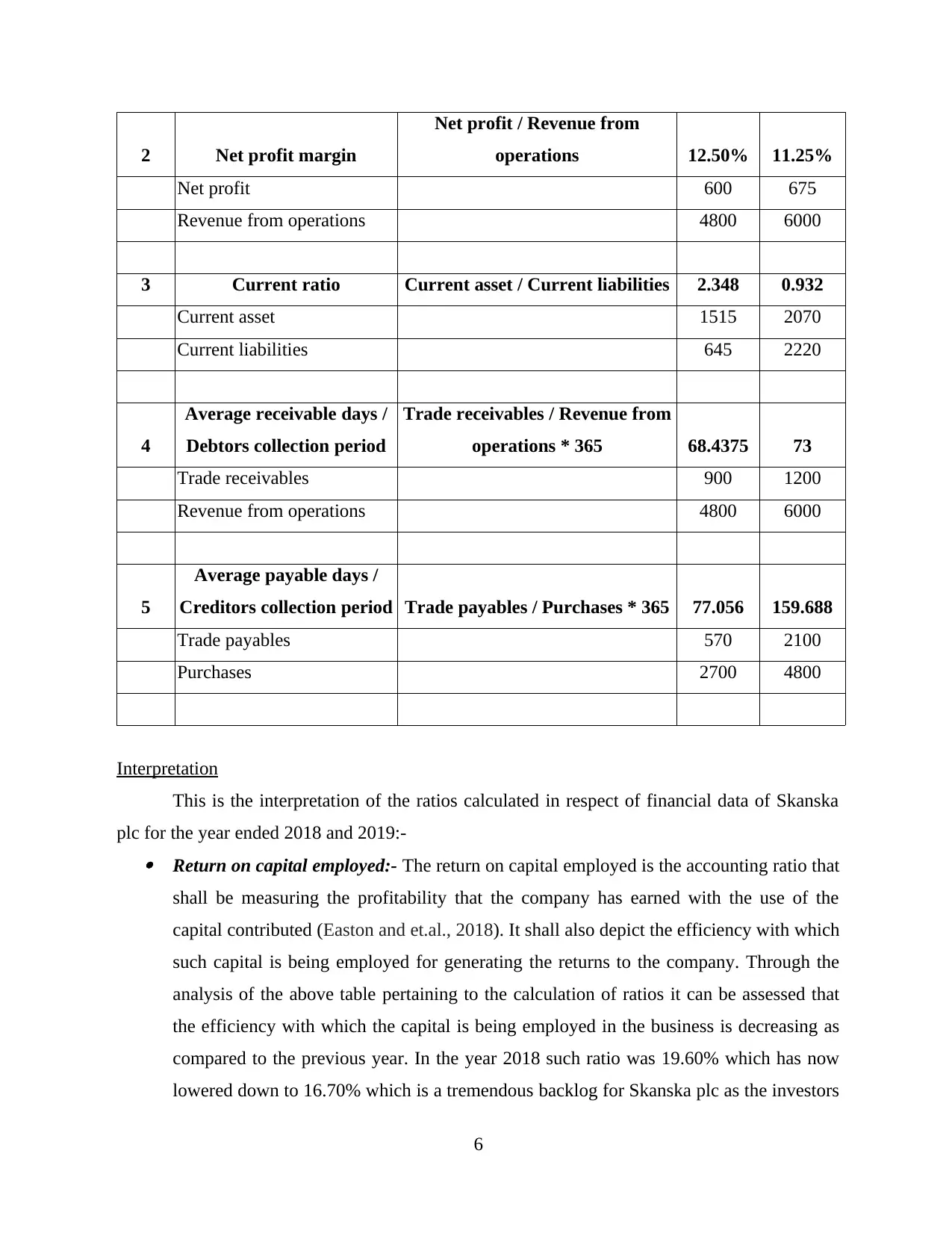
2 Net profit margin
Net profit / Revenue from
operations 12.50% 11.25%
Net profit 600 675
Revenue from operations 4800 6000
3 Current ratio Current asset / Current liabilities 2.348 0.932
Current asset 1515 2070
Current liabilities 645 2220
4
Average receivable days /
Debtors collection period
Trade receivables / Revenue from
operations * 365 68.4375 73
Trade receivables 900 1200
Revenue from operations 4800 6000
5
Average payable days /
Creditors collection period Trade payables / Purchases * 365 77.056 159.688
Trade payables 570 2100
Purchases 2700 4800
Interpretation
This is the interpretation of the ratios calculated in respect of financial data of Skanska
plc for the year ended 2018 and 2019:- Return on capital employed:- The return on capital employed is the accounting ratio that
shall be measuring the profitability that the company has earned with the use of the
capital contributed (Easton and et.al., 2018). It shall also depict the efficiency with which
such capital is being employed for generating the returns to the company. Through the
analysis of the above table pertaining to the calculation of ratios it can be assessed that
the efficiency with which the capital is being employed in the business is decreasing as
compared to the previous year. In the year 2018 such ratio was 19.60% which has now
lowered down to 16.70% which is a tremendous backlog for Skanska plc as the investors
6
Net profit / Revenue from
operations 12.50% 11.25%
Net profit 600 675
Revenue from operations 4800 6000
3 Current ratio Current asset / Current liabilities 2.348 0.932
Current asset 1515 2070
Current liabilities 645 2220
4
Average receivable days /
Debtors collection period
Trade receivables / Revenue from
operations * 365 68.4375 73
Trade receivables 900 1200
Revenue from operations 4800 6000
5
Average payable days /
Creditors collection period Trade payables / Purchases * 365 77.056 159.688
Trade payables 570 2100
Purchases 2700 4800
Interpretation
This is the interpretation of the ratios calculated in respect of financial data of Skanska
plc for the year ended 2018 and 2019:- Return on capital employed:- The return on capital employed is the accounting ratio that
shall be measuring the profitability that the company has earned with the use of the
capital contributed (Easton and et.al., 2018). It shall also depict the efficiency with which
such capital is being employed for generating the returns to the company. Through the
analysis of the above table pertaining to the calculation of ratios it can be assessed that
the efficiency with which the capital is being employed in the business is decreasing as
compared to the previous year. In the year 2018 such ratio was 19.60% which has now
lowered down to 16.70% which is a tremendous backlog for Skanska plc as the investors
6
⊘ This is a preview!⊘
Do you want full access?
Subscribe today to unlock all pages.

Trusted by 1+ million students worldwide
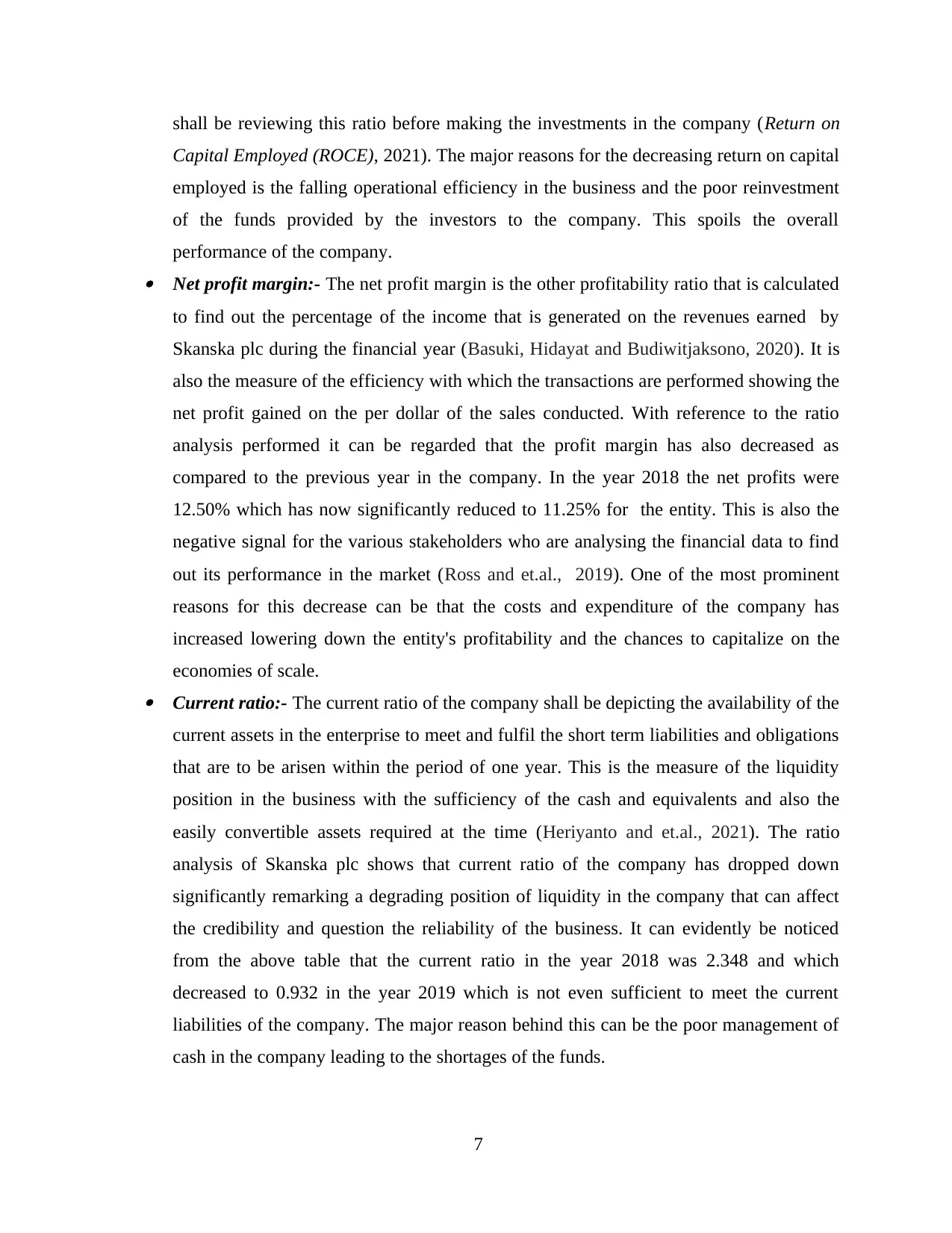
shall be reviewing this ratio before making the investments in the company (Return on
Capital Employed (ROCE), 2021). The major reasons for the decreasing return on capital
employed is the falling operational efficiency in the business and the poor reinvestment
of the funds provided by the investors to the company. This spoils the overall
performance of the company. Net profit margin:- The net profit margin is the other profitability ratio that is calculated
to find out the percentage of the income that is generated on the revenues earned by
Skanska plc during the financial year (Basuki, Hidayat and Budiwitjaksono, 2020). It is
also the measure of the efficiency with which the transactions are performed showing the
net profit gained on the per dollar of the sales conducted. With reference to the ratio
analysis performed it can be regarded that the profit margin has also decreased as
compared to the previous year in the company. In the year 2018 the net profits were
12.50% which has now significantly reduced to 11.25% for the entity. This is also the
negative signal for the various stakeholders who are analysing the financial data to find
out its performance in the market (Ross and et.al., 2019). One of the most prominent
reasons for this decrease can be that the costs and expenditure of the company has
increased lowering down the entity's profitability and the chances to capitalize on the
economies of scale. Current ratio:- The current ratio of the company shall be depicting the availability of the
current assets in the enterprise to meet and fulfil the short term liabilities and obligations
that are to be arisen within the period of one year. This is the measure of the liquidity
position in the business with the sufficiency of the cash and equivalents and also the
easily convertible assets required at the time (Heriyanto and et.al., 2021). The ratio
analysis of Skanska plc shows that current ratio of the company has dropped down
significantly remarking a degrading position of liquidity in the company that can affect
the credibility and question the reliability of the business. It can evidently be noticed
from the above table that the current ratio in the year 2018 was 2.348 and which
decreased to 0.932 in the year 2019 which is not even sufficient to meet the current
liabilities of the company. The major reason behind this can be the poor management of
cash in the company leading to the shortages of the funds.
7
Capital Employed (ROCE), 2021). The major reasons for the decreasing return on capital
employed is the falling operational efficiency in the business and the poor reinvestment
of the funds provided by the investors to the company. This spoils the overall
performance of the company. Net profit margin:- The net profit margin is the other profitability ratio that is calculated
to find out the percentage of the income that is generated on the revenues earned by
Skanska plc during the financial year (Basuki, Hidayat and Budiwitjaksono, 2020). It is
also the measure of the efficiency with which the transactions are performed showing the
net profit gained on the per dollar of the sales conducted. With reference to the ratio
analysis performed it can be regarded that the profit margin has also decreased as
compared to the previous year in the company. In the year 2018 the net profits were
12.50% which has now significantly reduced to 11.25% for the entity. This is also the
negative signal for the various stakeholders who are analysing the financial data to find
out its performance in the market (Ross and et.al., 2019). One of the most prominent
reasons for this decrease can be that the costs and expenditure of the company has
increased lowering down the entity's profitability and the chances to capitalize on the
economies of scale. Current ratio:- The current ratio of the company shall be depicting the availability of the
current assets in the enterprise to meet and fulfil the short term liabilities and obligations
that are to be arisen within the period of one year. This is the measure of the liquidity
position in the business with the sufficiency of the cash and equivalents and also the
easily convertible assets required at the time (Heriyanto and et.al., 2021). The ratio
analysis of Skanska plc shows that current ratio of the company has dropped down
significantly remarking a degrading position of liquidity in the company that can affect
the credibility and question the reliability of the business. It can evidently be noticed
from the above table that the current ratio in the year 2018 was 2.348 and which
decreased to 0.932 in the year 2019 which is not even sufficient to meet the current
liabilities of the company. The major reason behind this can be the poor management of
cash in the company leading to the shortages of the funds.
7
Paraphrase This Document
Need a fresh take? Get an instant paraphrase of this document with our AI Paraphraser
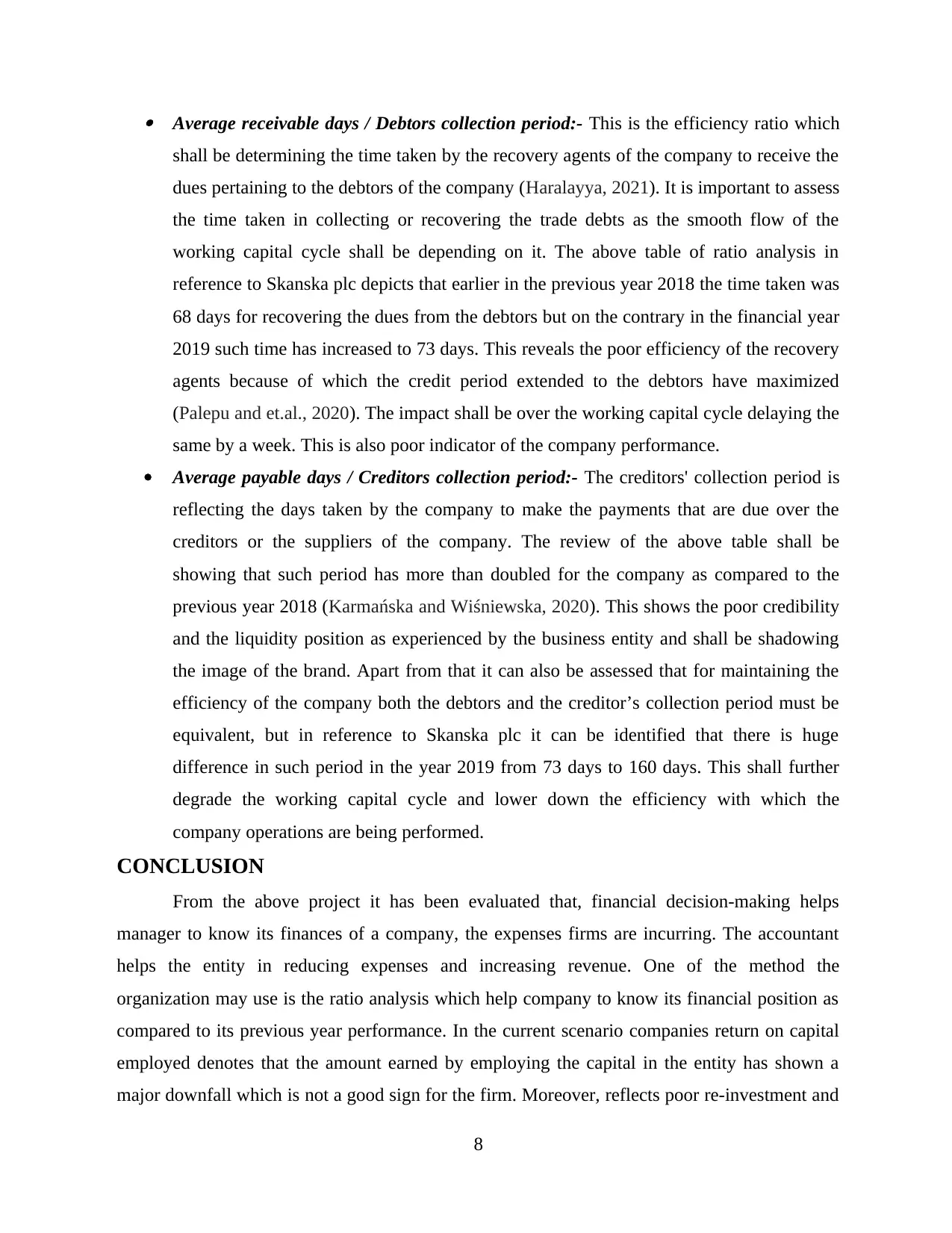
Average receivable days / Debtors collection period:- This is the efficiency ratio which
shall be determining the time taken by the recovery agents of the company to receive the
dues pertaining to the debtors of the company (Haralayya, 2021). It is important to assess
the time taken in collecting or recovering the trade debts as the smooth flow of the
working capital cycle shall be depending on it. The above table of ratio analysis in
reference to Skanska plc depicts that earlier in the previous year 2018 the time taken was
68 days for recovering the dues from the debtors but on the contrary in the financial year
2019 such time has increased to 73 days. This reveals the poor efficiency of the recovery
agents because of which the credit period extended to the debtors have maximized
(Palepu and et.al., 2020). The impact shall be over the working capital cycle delaying the
same by a week. This is also poor indicator of the company performance.
Average payable days / Creditors collection period:- The creditors' collection period is
reflecting the days taken by the company to make the payments that are due over the
creditors or the suppliers of the company. The review of the above table shall be
showing that such period has more than doubled for the company as compared to the
previous year 2018 (Karmańska and Wiśniewska, 2020). This shows the poor credibility
and the liquidity position as experienced by the business entity and shall be shadowing
the image of the brand. Apart from that it can also be assessed that for maintaining the
efficiency of the company both the debtors and the creditor’s collection period must be
equivalent, but in reference to Skanska plc it can be identified that there is huge
difference in such period in the year 2019 from 73 days to 160 days. This shall further
degrade the working capital cycle and lower down the efficiency with which the
company operations are being performed.
CONCLUSION
From the above project it has been evaluated that, financial decision-making helps
manager to know its finances of a company, the expenses firms are incurring. The accountant
helps the entity in reducing expenses and increasing revenue. One of the method the
organization may use is the ratio analysis which help company to know its financial position as
compared to its previous year performance. In the current scenario companies return on capital
employed denotes that the amount earned by employing the capital in the entity has shown a
major downfall which is not a good sign for the firm. Moreover, reflects poor re-investment and
8
shall be determining the time taken by the recovery agents of the company to receive the
dues pertaining to the debtors of the company (Haralayya, 2021). It is important to assess
the time taken in collecting or recovering the trade debts as the smooth flow of the
working capital cycle shall be depending on it. The above table of ratio analysis in
reference to Skanska plc depicts that earlier in the previous year 2018 the time taken was
68 days for recovering the dues from the debtors but on the contrary in the financial year
2019 such time has increased to 73 days. This reveals the poor efficiency of the recovery
agents because of which the credit period extended to the debtors have maximized
(Palepu and et.al., 2020). The impact shall be over the working capital cycle delaying the
same by a week. This is also poor indicator of the company performance.
Average payable days / Creditors collection period:- The creditors' collection period is
reflecting the days taken by the company to make the payments that are due over the
creditors or the suppliers of the company. The review of the above table shall be
showing that such period has more than doubled for the company as compared to the
previous year 2018 (Karmańska and Wiśniewska, 2020). This shows the poor credibility
and the liquidity position as experienced by the business entity and shall be shadowing
the image of the brand. Apart from that it can also be assessed that for maintaining the
efficiency of the company both the debtors and the creditor’s collection period must be
equivalent, but in reference to Skanska plc it can be identified that there is huge
difference in such period in the year 2019 from 73 days to 160 days. This shall further
degrade the working capital cycle and lower down the efficiency with which the
company operations are being performed.
CONCLUSION
From the above project it has been evaluated that, financial decision-making helps
manager to know its finances of a company, the expenses firms are incurring. The accountant
helps the entity in reducing expenses and increasing revenue. One of the method the
organization may use is the ratio analysis which help company to know its financial position as
compared to its previous year performance. In the current scenario companies return on capital
employed denotes that the amount earned by employing the capital in the entity has shown a
major downfall which is not a good sign for the firm. Moreover, reflects poor re-investment and
8
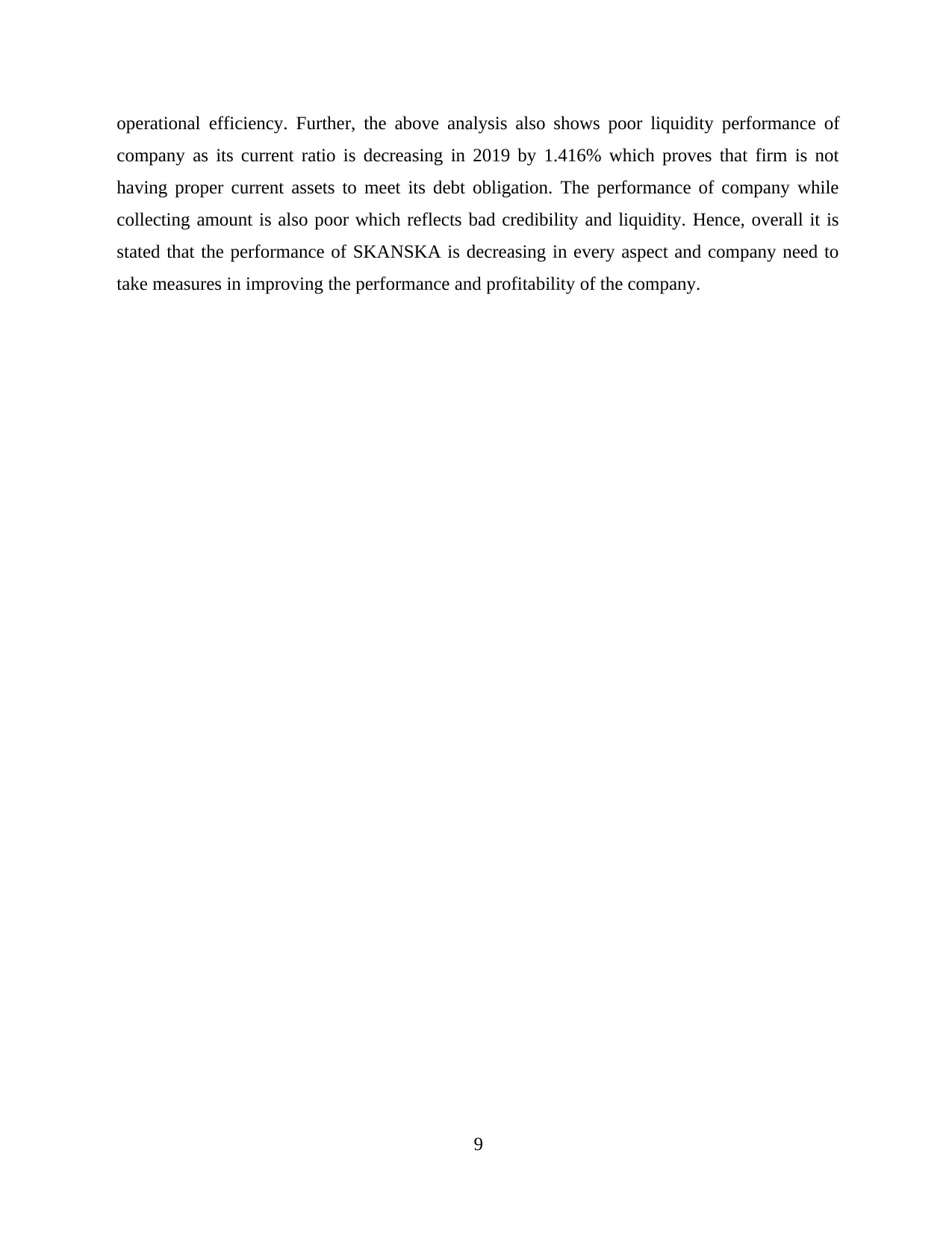
operational efficiency. Further, the above analysis also shows poor liquidity performance of
company as its current ratio is decreasing in 2019 by 1.416% which proves that firm is not
having proper current assets to meet its debt obligation. The performance of company while
collecting amount is also poor which reflects bad credibility and liquidity. Hence, overall it is
stated that the performance of SKANSKA is decreasing in every aspect and company need to
take measures in improving the performance and profitability of the company.
9
company as its current ratio is decreasing in 2019 by 1.416% which proves that firm is not
having proper current assets to meet its debt obligation. The performance of company while
collecting amount is also poor which reflects bad credibility and liquidity. Hence, overall it is
stated that the performance of SKANSKA is decreasing in every aspect and company need to
take measures in improving the performance and profitability of the company.
9
⊘ This is a preview!⊘
Do you want full access?
Subscribe today to unlock all pages.

Trusted by 1+ million students worldwide
1 out of 13
Related Documents
Your All-in-One AI-Powered Toolkit for Academic Success.
+13062052269
info@desklib.com
Available 24*7 on WhatsApp / Email
![[object Object]](/_next/static/media/star-bottom.7253800d.svg)
Unlock your academic potential
Copyright © 2020–2025 A2Z Services. All Rights Reserved. Developed and managed by ZUCOL.




